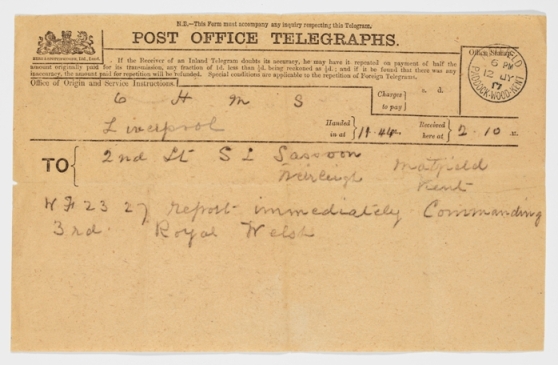
Telegram commanding Sassoon to report for duty found in the journal MS Add.9852/1/11
This terse telegram was sent to Sassoon on 12 July 1917 by his commanding officer in the wake of the publication of his ‘Soldiers Declaration’. Sassoon was deliberately overstaying sick leave permitted for recuperation from a bullet wound sustained at Arras. When Sassoon did indeed report to Litherland depot he fully expected, and in fact hoped for publicity’s sake, to be arrested and court-martialled. Instead he was directed to put up in the Exchange Hotel in nearby Liverpool to await further instruction. The government War Office, to whom the Army had referred the matter, were determined not to allow the statement to become a public cause. They, partially influenced by the intervention of various friends including Robert Graves, resolved the stand off by sending Sassoon to Craiglockhart Hospital near Edinburgh to recover from ”neurasthenia”or shell shock. At Craiglockhart Sassoon was to meet and nurture one Wilfred Owen.
In his autobiographical work Siegfried’s Journey Sassoon makes an interesting observation when describing his slowness in appreciating the ‘exceptional quality of [Wilfred Owen’s] poetic gift’. ‘Manuscript poems’, he writes, ‘can be deceptive when handed to one like school exercises to be blue pencilled, especially when one has played thirty-six holes of golf and consumed a stodgy hospital dinner’ (page 59). It seems that Sassoon was deeply aware of the aesthetics of his work in both manuscript and published form. From childhood onwards many of his manuscript poems are to be found accompanied by his own diligently laid out watercolour decorations, and his attention to correcting printers’ proofs appear to show a concern for the visual impact of the printed word on the page. Is this perhaps an influence of his maternal Thornycroft artistic lineage?
